Collision Course
To save endangered whales, New England’s iconic lobster industry is facing unpopular and possibly dangerous changes.
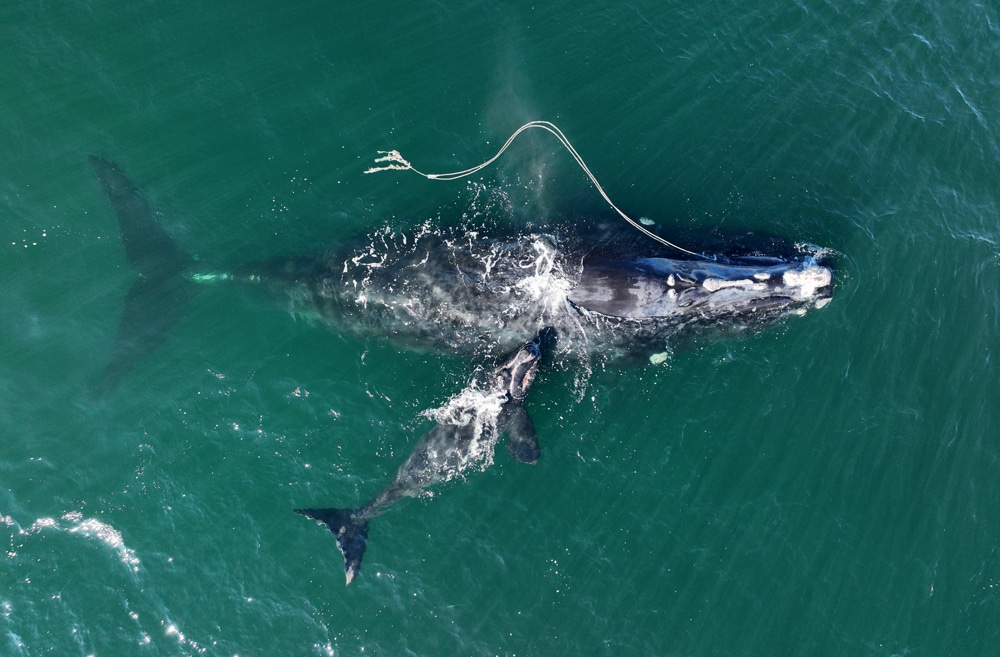
First seen entangled in fishing gear in spring 2021, the North Atlantic right whale known as Snow Cone swims with her calf in December of that year, still trailing two lines.
Photo Credit : Photo courtesy of Georgia DNR/taken under NOAA permit 20556By Bill Donahue

Photo Credit : Photo courtesy of Georgia DNR/taken under NOAA permit 20556
On a cold March day last year, whale researcher Brigid McKenna gazed out the window of a low-flying small plane to the gray water off Cape Cod Bay and thought, Oh no, not another one.
A right whale—50 feet long, mostly black—was in trouble. Two long ropes dangled from the left side of its mouth, and McKenna suspected that the line was snarled in the whale’s baleen, the fine comb-like grill it has in place of teeth so that it can filter into its gut the 2,500 pounds of crustaceans that a right whale ingests every day. It seemed that the rope might also be caught in the whale’s rostrum, or snout; just 10 days earlier, off the coast of South Carolina, another right whale—Cottontail, it was called—was found dead after living for several months with its own rostrum wrap.
“You worry about infection when there’s a rostrum wrap,” says McKenna, who’s been a whale researcher for the Center for Coastal Studies, in Provincetown, since 2013. Rostrum wraps also pose serious challenges for rescue teams, who work out of small boats, wielding grapples and knives as they endeavor, like surgeons, to disentangle whales. As McKenna notes, “The rescuers have to be very close to the animal.”
And getting close to a right whale is dangerous. In 2017, Joe Howlett, a 59-year-old fisherman working with the Campobello Whale Rescue Team, died off the coast of New Brunswick, Canada, when he was struck by the tail of a whale he had just disentangled.
Looking at the whale in Cape Cod Bay, McKenna knew what was at stake. Today there are fewer than 400 North Atlantic right whales left on earth, out of a historic population of more than 9,000. This creature whose genetic roots go back 20 million years has been on the brink of extinction for more than two centuries, thanks to the early New Englanders who decided that this was the right whale to hunt—it was so big and blubbery, so slow-moving, so inclined to glide in toward shore.
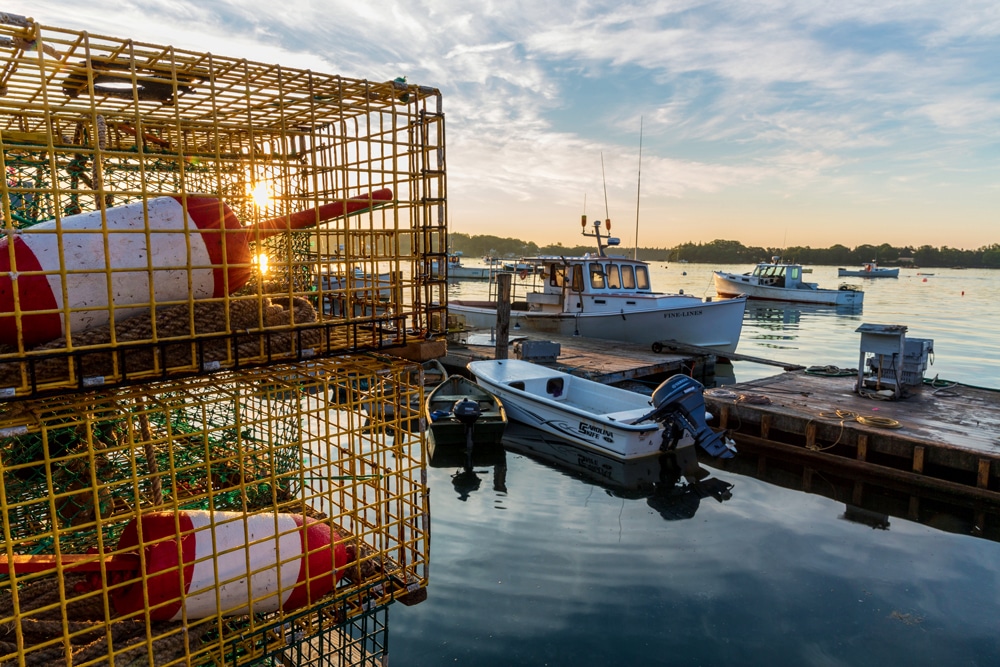
Photo Credit : Jerry Monkman/EcoPhotography
A 1937 ban halted the hunt worldwide, but in the 1960s advances in polymer technology for fishing lines began to pose a new threat. Since then, the lines have gradually become so strong that right whales can no longer break through them. Since 2017, of the more than 30 unusual whale deaths known to scientists, nine have been due to entanglements. Eleven were ship strikes, and 13 deaths were of an unknown cause.
The National Ocean and Atmospheric Administration (NOAA) estimates that 85 percent of today’s right whales bear scars of entanglement. Many have been left weakened, as entangled whales have trouble eating and lose weight. They may move more slowly, leaving them more vulnerable to being struck by ships, and they may have difficulty getting pregnant and bringing calves to term.
Federally listed as endangered since 1970, the North Atlantic right whale is now so scarce in its range, which stretches from Florida to Newfoundland, that researchers keep dossiers on individual whales and have named many. The one McKenna spied was a 17-year-old female called Snow Cone, on account of the snow cone–shaped scaratop her head.
Back in 2020, Snow Cone had given birth to a calf only to see the newborn die that same summer, after it was struck by two separate ships off the coast of New Jersey. Still a possible breeder, Snow Cone was key to the survival of her species.
McKenna called the Center for Coastal Studies’ whale rescue team, which has disentangled about 200 whales since it was founded 1976. Within minutes, the team’s six members were in their cars, scrambling toward the dock in Provincetown.
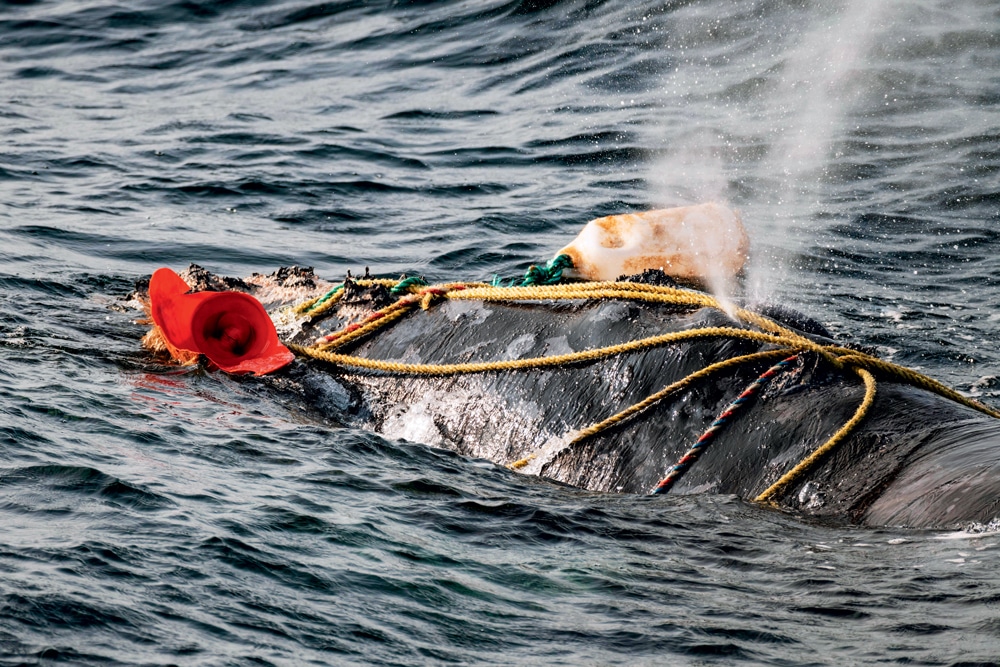
Photo Credit : Nick Hawkins/Nature Picture Library/Alamy Stock Photo
A hundred miles or so north, up Route 95, past Portsmouth, and past the big green highway sign that says, “Welcome to Maine,” the future of another endangered species was also in question: the Maine lobsterman, one of the most recognizable and revered figures in the state.
Today, there are 5,000 licensed lobster boats in Maine. They harvest 80 percent of the lobster sold nationwide and collectively grossed $725 million in 2021. Recently their industry has been flourishing—last summer, lobstermen had a jackpot season, earning more than seven dollars a pound for their catch.
But the average Maine lobsterman is now 51 years old. Younger Mainers are less and less interested in investing hundreds of thousands in a boat to chase after a marine resource that may well be scarce in a generation. As climate change warms the Gulf of Maine, lobster habitat will suffer. And since 1997, the entire U.S. lobster industry—which fishes in waters stretching from the Canadian border to Long Island Sound—has been required to make increasing accommodations for the right whale, nearly all aimed at reducing threats from vertical rope lines in the water.
In 2009, NOAA forbade lobstermen to crowd the water’s surface with ground lines linking their traps. To comply, new rules meant fishermen would need more expensive, less durable rope. Last August, NOAA released the Atlantic Large Whale Take Reduction Plan. Besides the emphasis on weaker ropes, it also placed more than 950 square miles in the Gulf of Maine—Lobster Management Area 1—off-limits from October through January. The Maine Lobstermen’s Association (MLA) estimated that its members would take a $2 million hit.
And restrictions on Maine lobstermen are likely to mount. Because the right whale is critically endangered, NOAA is obliged to protect it. In July the Arizona-based Center for Biological Diversity and its allies convinced a federal court that NOAA’s new rules do not, in fact, do that sufficiently.
For lobstermen, the danger posed by restrictions goes beyond economics. A regulatory fence has been thrown up in the face of New England’s famously independent sea foragers. For decades, Mainers have been allowed to fish 800 traps per boat license every day of the year. Now, daily life in lobstering towns like Stonington, Winter Harbor, and Lubec seems poised to change. And change does not come easily to such towns.
Patrick Keliher, commissioner of Maine’s Department of Marine Resources, reacted to NOAA’s rule announcement by saying, “They’re painting a big target on the back of the Maine lobster industry.” And even Maine’s Democratic governor, Janet Mills, a climate change activist who once climbed into a black bear den to extoll “treasured wildlife,” called the NOAA decision “extremely disappointing.” Nodding to “heritage,” Mills vowed, “I will always stand up for the interests of Maine’s lobster industry.” She added that NOAA’s changes “disregard fishermen’s time, money, and safety.”
On that last point, safety: Lobstermen have long been accustomed to attaching one, two, or three traps to each buoy. Now, per NOAA’s plan, they will often need to attach more, to reduce the number of lines that could ensnare a whale. Thus lobster boats will need to carry more traps to their fishing grounds. Their boat decks will be more cluttered, andclutter can be dangerous when, after traps are emptied, the trawl line is spooled back into the water so quickly that it snaps and dances about the deck. In 2016, Jon Popham, a 28-year-old Maine lobsterman, drowned off Jonesport after his foot got caught in a fast-moving line that pulled him overboard. It was an accident that has been repeated scores of times over the decades.
When I spent a few days late last summer visiting with Maine lobstermen, I encountered almost unmitigated bitterness toward NOAA. One evening as I sat at a waterfront picnic table in Friendship, Maine, tucking into fresh lobster with a few fishermen, a 35-year-old local named Gabe Gilchrest sidled up from his boat and broke into a pained soliloquy. “Who are these people putting all these rules out?” he said. “And why are they so determined to shut us down? Do they not care about our families? And how do they make a living? By trying to make sure we can’t make a living? I wish they’d come to Friendship so I could show them what they’re trying to ruin.”
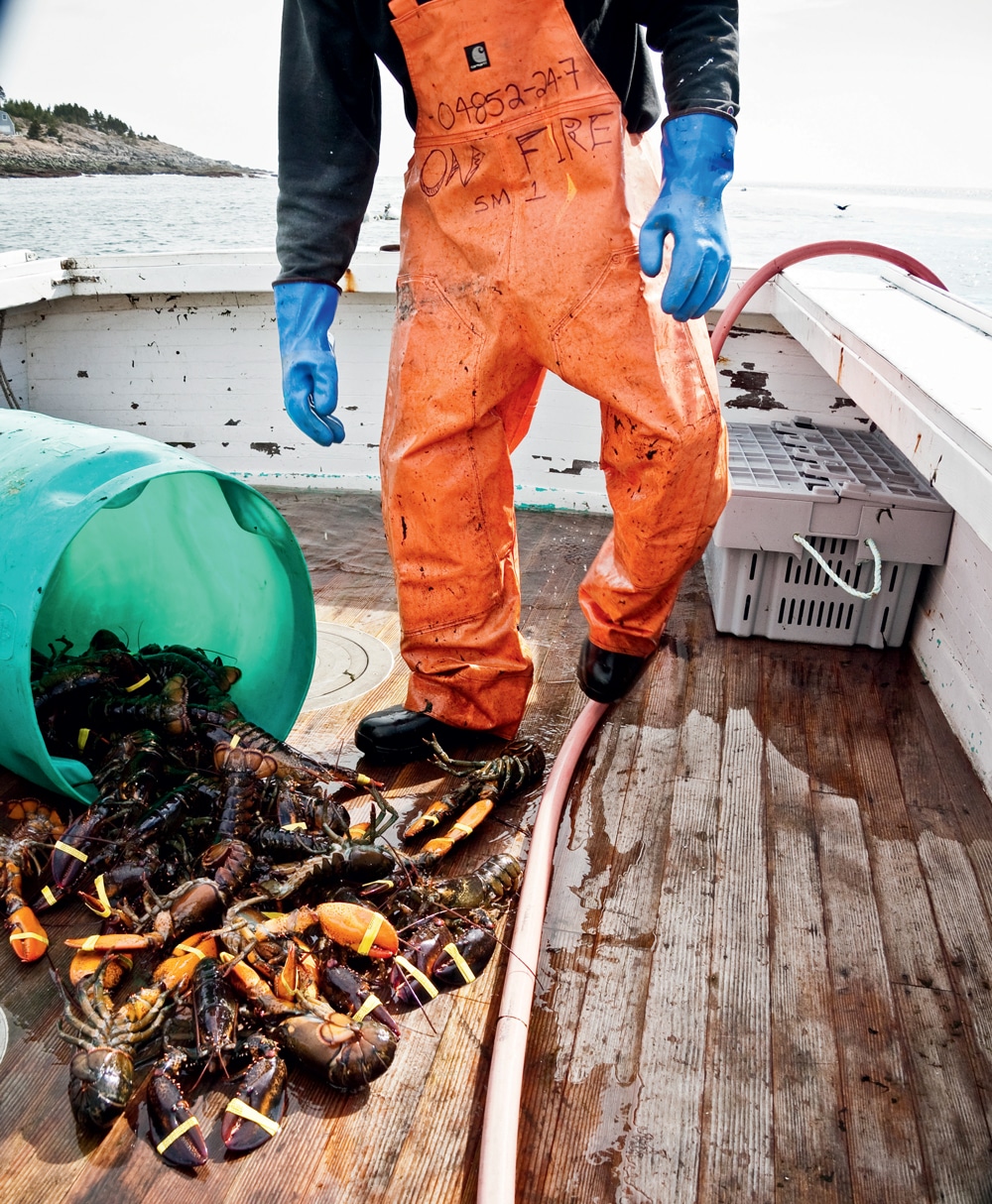
Photo Credit : Peter Frank Edwards/Redux Pictures
The next evening, 112 miles up the coast, in Milbridge, I drove toward a fishing dock with lobsterman Mike Sargent. He pointed out newly purchased million-dollar-plus vacation homes as we passed them, their lawns an eerie bright green. We reached the pocked pavement by the dock, parked, and then lingered on the water’s edge, leaning on dinghies. Sargent, who’s 29, showed me the tattoo on his right arm, an homage to his late father, a lobsterman, who inspired Sargent. “Dedication Discipline Determination,” his arm read, the words wrapping a spiked trident held by a comely mermaid with a scaled green tail.
As the sun set, Sargent expounded on the joys of the lobstering life. “I go out and see the sunrise every day,” he said. “I watch the seabirds nesting on the rocks. I watch their babies get bigger. I read the book of nature every day. I look at the moon, the tides, at what’s happening in the climate. I add all that together with a lifetime of learning about how lobsters behave, and then I move my traps. I put a certain fish in them, based on what I’ve seen, and if I do it all right I come back successful. It’s such a unique life we have here, and we’ve got it only because we have access to lobsters. That’s the lifeblood of these little Down East villages. And when those villages lose their spirit, we won’t get them back. They’re gone.”
That March day,after Brigid McKenna had alerted the Center for Coastal Studies, the entanglement team found Snow Cone by 2 p.m.—and the team’s leader, Scott Landry, took a close look at the whale’s rostrum. “There was a pretty severe laceration there,” he tells me, months later, “and the rostrum is where a whale’s flesh is the thinnest—there’s not a lot there before you start infecting the skull.”
The cut was weeks old, Landry guessed. It was healing, and the rope was no longer embedded there. It was simply jutting out of the baleen and trailing at the whale’s sides, and Snow Cone’s health seemed “not that bad,” says Landry, who’s responded to 100 whale entanglements over the past quarter century. “She was actively feeding—a lot of entangled whales can’t do that.” She had energy, too.
Seemingly feeling harassed, the whale began evading the scientists by plunging deep under the surface. Sometimes she’d stay down two minutes, sometimes 20. In the long intervals, the rescuers could only wait as they guessed where the whale would surface.

Photo Credit : Leslie Bowman for the Island Journal, published by the Island Institute
Those 20-minute plunges, the half-mile swims that right whales take in the cold darkness between breaths; their 15-foot-wide flukes and the way those flukes move so slowly, like great, powerful engines grinding along in low gear—none of this computes in human terms. All we can do, in the presence of a right whale, is register awe, and it’s probably that awe—and the improbable delight that, in our anthropocentric world, there’s still a force larger than us—that makes the North Atlantic right whale one of the most studied, most defended creatures on earth. In New England alone, there are more than 30 groups working on right whale preservation. All for an animal that, according to Stormy Mayo, the senior scientist at the Center for Coastal Studies, is “now so rare that it’s not playing a huge role in the ecosystem. There are so few that a school of herring is performing the same general role.”
When Snow Cone surfaced, the scientists chased her. They latched a buoy onto her, to reduce the length of her dives. She dragged it under. The scientists waited, and in rare moments over a two-plus-hour struggle, they got within 20 feet of her, warily. Right whales are the hardest whales to disentangle. “They have a lot of stamina and strength,” Landry explains, “because they move through the water with their mouths open, filtering food—that’s like swimming in a pool with a bucket in front of you.”
To remove rope from Snow Cone’s mouth, the team had to position their boat directly in her path, and she was certain to see their presence as hostile. “They’re intolerant of being captured,” Landry explains. “You feel like you’re taking a small child to the hospital.” Except the child weighs 50 tons and can, in fits of irritation, thrash its tail forward until it touches its nose.
Carefully, Landry thrust a grapple affixed with a knife toward Snow Cone; with about 10 such throws, he cut 300 feet of rope off the whale. It was a decent pruning job, but also an incomplete one. And with the sun going down, the light became too flat to work safely.
When Landry’s team headed back to the harbor, Snow Cone swam away. The rope remained in her baleen, and its two ends extended for about 60 feet behind her flukes. A certain doom seemed to envelop her. No right whale had ever given birth while still entangled in rope.
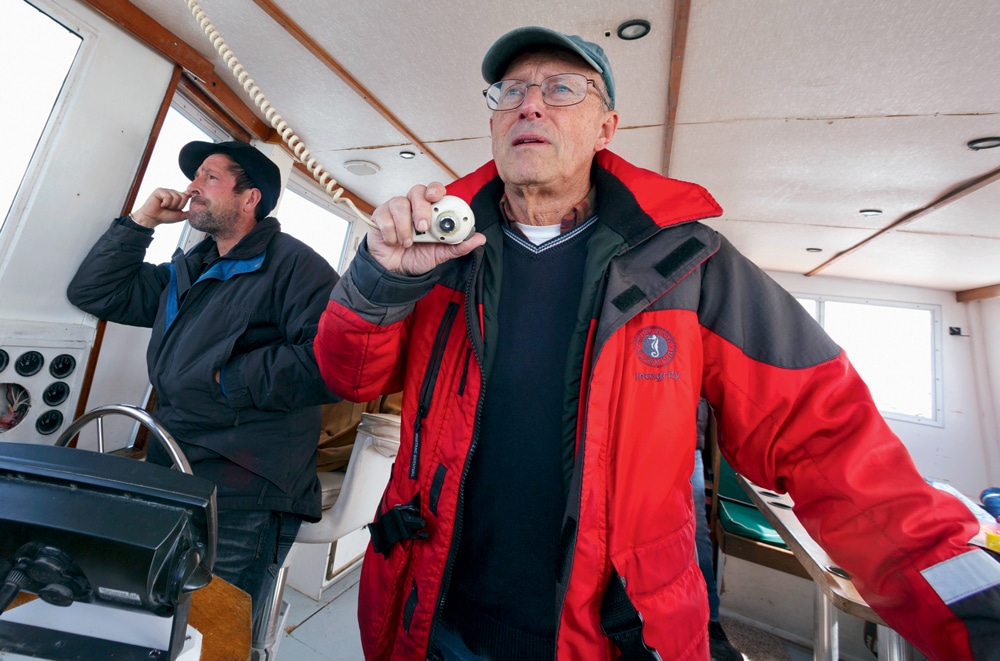
Photo Credit : Michael Dwyer/AP Photo
Two days after his Snow Cone mission, Landry wrote on Facebook that the rope his team pulled off the whale was “consistent with what we see in different types of fisheries.” He didn’t say which fishery, but Chatham, Massachusetts, lobsterman Nick Muto still felt attacked. Muto minted a Facebook hashtag, #showustherope, that elicited media attention and a slew of online fist bumps from his lobstering brethren.
The hashtag was unlikely to convince NOAA to place the rope in a glass display case and bring it on tour of New England lobstering towns. Nearly all lines and buoys recovered from entanglements land, per long-established NOAA protocol, in a Rhode Island warehouse, where NOAA investigators painstakingly examine them, seeking to piece together the larger story of how right whales get trapped.
Still, Muto spoke out because he saw Landry’s online photos as proof that the lobstermen on and near Cape Cod Bay weren’t to blame for Snow Cone’s troubles. “That was 5/8-inch rope on that whale,” he tells me, “and we don’t use anything thicker than 11/32.”
Muto is probably on solid ground, refusing to be blamed. If Snow Cone’s wounds were, as Landry surmised, several weeks old in early March, she wouldn’t likely have incurred them anywhere near Cape Cod. The Cape is the easiest place in the world to see large groups of North Atlantic right whales, and for this reason its waters are closed to lobstering all winter.
As to where the whales are at other times, it’s never quite clear. Often, pregnant mothers go south, to Georgia and Florida, to deliver. But they don’t always do that, and other whales swim there as well. “Nothing about their movement patterns is carved in granite,” says Stormy Mayo.
The unpredictability makes entanglement-blame a political football. After NOAA crimped Maine’s lobster fishery last fall, MLA president Kristan Porter suggested that right whale deaths weren’t Maine’s fault. “We can’t stop whales from getting killed in Canada,” he said, speaking to The Ellsworth American.
Porter was alluding to the summer of 2017, when Canada played host to a devastating right whale tragedy. Twelve corpses were found one by one that summer, amid sparse fishing regulations, in the Gulf of St. Lawrence, northeast of Nova Scotia. Two years later, six more died.
But Colleen Coogan, a marine mammal biologist for NOAA, argues that Maine’s fishermen actually do play a role in Canadian whale deaths. Right whales travel through Maine, she says, “and they’re not easily seen there, because in Maine they’re probably not in large aggregations. I don’t have evidence that the gear from the Canadian deaths came from Kristan Porter’s port in Maine, but the gear is highly concentrated there, and wherever there’s both gear and right whales, there are entanglements.”
Coogan adds that the New England Aquarium has studied 1,600 right whale scars, and in only 15 cases was it able to identify where the fishing gear came from. Almost always, the telltale buoys and markers fall off in the water.
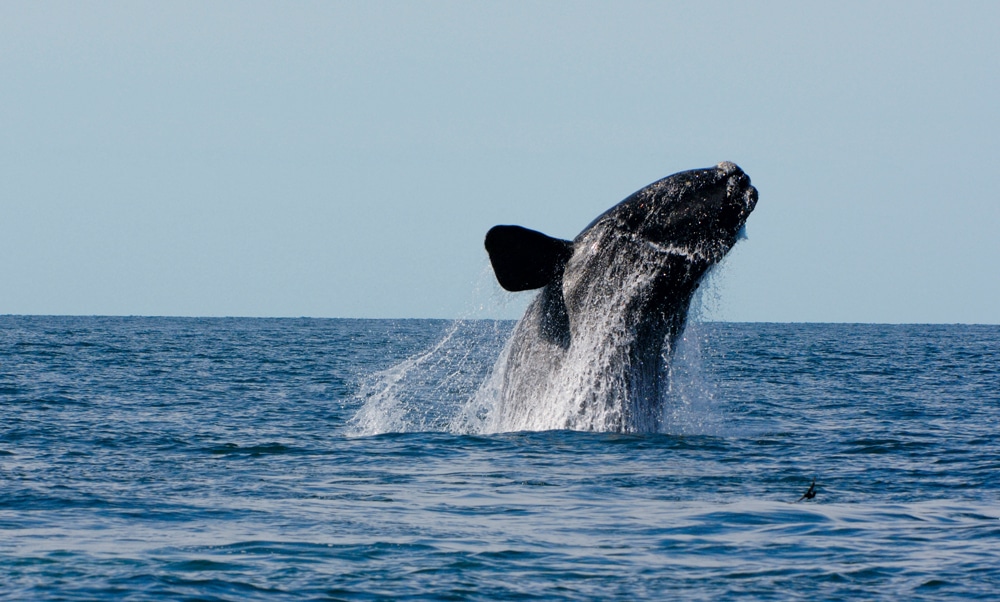
Photo Credit : Brian Skerry
But NOAA isn’t in the business of assigning blame. It assumes, reasonably, that malice never plays a part in entanglements, and it never prosecutes fishermen. Its charge is to protect the right whale throughout its range. And in the waters of the northeastern U.S., 93 percent of the ropes that run from surface to seafloor—the ones most likely to entangle whales—come from the lobster and Jonah crab fisheries.
As Snow Cone churned awayfrom Scott Landry near Plymouth, a few dozen New England lobstermen were testing a new technology designed to mitigate whale entanglement. First popularized in New England four or five years ago, “ropeless” lobster traps sit on the bottom like all other traps but are not marked by surface buoys, which means that they can function without adding a vertical line to the water column. They’re remote-controlled, so if a lobsterman wants to bring one up, he presses a button. A transponder then sends an electronic signal to a small motor in the trap’s lid. The motor unscrews the lid, which has buoys attached to it, and the whole trap then comes floating up to the surface, dragging along with it a string of other traps.
In Maine’s Area 1, NOAA is allowing licensed boats to harvest lobster during the October to January closure if they use ropeless traps. But these traps can cost nearly $4,000 apiece, and to go ropeless, a lobsterman needs to buy one such trap for each of his trap lines. For a Maine lobsterman, that could easily amount to an outlay of over $100,000, or about half of an average boat’s gross annual revenue.
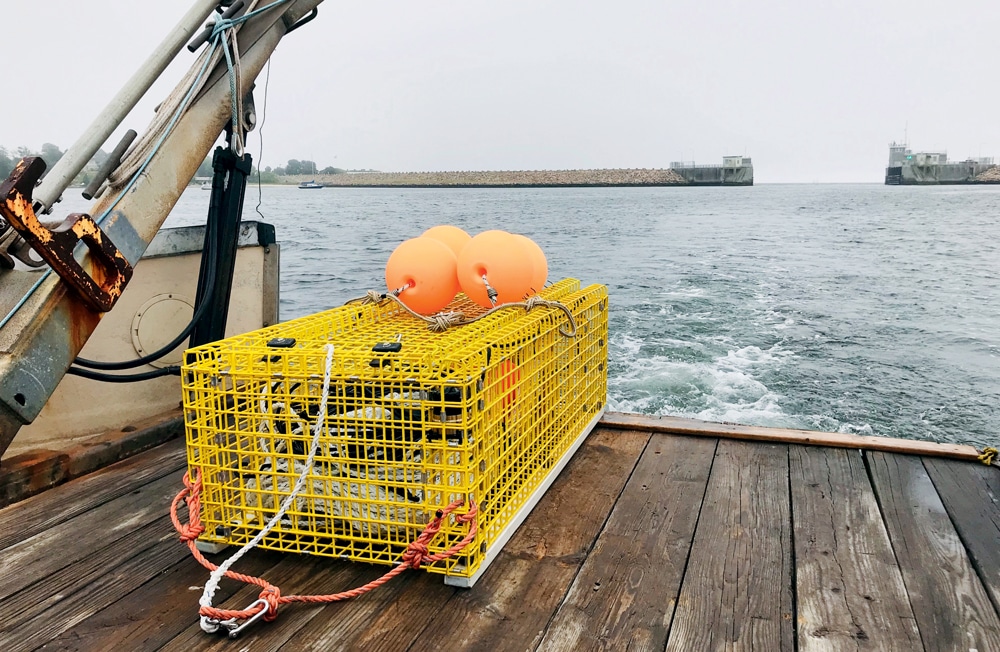
Photo Credit : courtesy of EdgeTech
When I first heard that number, I still considered ropeless as a feasible fix for the right whale conundrum, and I was on board with the billboards that began appearing around Massachusetts last year, asking consumers, “Is your lobster whale-safe?”
But then I spent a morning off Massachusetts’s South Shore with Mike Lane, a 46-year-old lobsterman who for three years has moonlighted as a NOAA contractor, helping the agency to field-test ropeless technology, including a trap made by a Central Massachusetts company called EdgeTech.
Lane’s principal gift as a gear reviewer is his candor. When a digital map told us we were near the ropeless trap, Lane fished out a black, fist-size EdgeTech transponder and wrangled a long, awkward cord connecting the unit to a handheld tablet. “This transponder,” he said, “is a pain in the ass.”
EdgeTech does make a hull mount for its transponders; Lane simply doesn’t have one yet. But he summoned up his 15-trap line seamlessly. Then he celebrated his catch with a gruff “Eight lobsters, not bad,” and spooled his trap line back into the water. The rope lashed about on the deck, and Lane told me about a friend of his who, years ago, got pulled under and drowned.
“Usually, when a guy goes down like that,” he said, “you can see the buoy attached to the rope, and you pull it up. With ropeless, though, you can’t do that. They need to have a panic button on these things, and they don’t have one now. Right now, ropeless is about as advanced as cell phones were in the 1980s.”
When I spoke to Kristan Porter, the MLA president, about ropeless traps, he was more skeptical as he explained a problem specific to Maine. “We fish in crowded bays here,” he said. “All the boats are almost on top of each other, and if you’re fishing ropeless, without buoys on the surface, how am I going to know where your gear is? I’m going to set right on top of you and we’ll spend all day untangling ropes.”
Even Stormy Mayo, who began making grand speeches about the promise of ropeless technology decades ago, concedes, “We’re still eight or ten years away.”
When I met one afternoon with the inventors of a ropeless trap, they agreed. Kevin Rand and Richard Riels are the masterminds behind the Sea Mammal Education Learning Technology Society (SMELTS). We convened on a dock in Woods Hole. Reils, who is SMELTS’s director, told me, “You’re coming in at the foundation of an emerging technology.” He added, “The U.S. space program didn’t fly a man to the moon on day one.”
Eventually, Riels and Rand heaved their 60-pound trap into the shallow water. Riels pressed some buttons on his phone, manipulating a SMELTS app, and we waited in the expectation that the traps would rise to the surface in a moment. Then we kept waiting. Minutes passed, awkwardly. Riels and Rand punched at their phones. The trap didn’t come up.
“It’s like when you get a new cell phone,” Rand explained. “You have to get used to it.” The electronics on the trap are “more finicky when you’re not out on the water,” he said. “Here on shore, there’s a lot more Bluetoothing interference.”
Ten minutes passed. Then, finally, the trap emerged from the murk.
As the spring of 2021 came on and the water warmed, Snow Cone moved north, through Maine. No one saw her there, but in early May, a whale observation crew flying aerial surveys for the Canadian government spotted her in the Gulf of St. Lawrence. The rope was still in her mouth, but the next day, when the nonprofit Canadian Whale Institute sent out a rescue team, she seemed to be thriving. “She was in there socializing with other whales,” says Mackie Greene, a fisherman who was driving the rescue boat that day, “and she was strong. We tied her to the boat and just let her give us a Nantucket sleigh ride. I’ve never seen a whale pull so hard.”
Greene’s team spent four hours trimming more rope off of Snow Cone. Afterward, the rope was still in her baleen. But, Greene tells me, “it was older rope, and it looked like it was wearing out.”
This wasn’t the only ray of hope I encountered in reporting this story. I came across a 2020 research paper that suggested that whale-related restrictions might not kill Maine’s economy and culture after all. Writing in the journal Marine Policy, lead author Hannah Myers, an Alaska graduate student and a guest scientist at Woods Hole Oceanographic Institute, looked at lobster fisheries in Massachusetts and in Canada’s vast Lobster Fishing Area 34, off Nova Scotia. Both fisheries have endured closures. Still, profits are soaring. In Area 34, Myers found, Canadian fishermen were catching 3.7 more lobsters per trap than their Maine counterparts.

Photo Credit : courtesy of Maine Lobster Marketing Collaborative
Myers suggested that Maine’s lobstermen would bring home no less product if they worked fewer days and burned through less gas and money. She added that, with climate change poised to reduce the state’s lobster stock, “it is in the best interest of fishers to scale back effort in advance of an ecological or economic crisis.”
In Maine, Myers’s take is widely dismissed. “That paper,” Porter told me, “is full of errors.” I asked him for specifics, and he said, “I didn’t read it. It wasn’t even peer-reviewed.”
The paper was peer-reviewed, actually. But I understand Porter’s being skeptical of insights brought in from outside Maine waters. In lobstering, wisdom tends to be local.
Still, fisheries evolve. I think back now on my visit with Mike Lane on the South Shore. Lane was as salty as any lobstermen I’d met, his yard scattered with busted ancient traps and his diction rich with old-school profanity. Still, he’d changed how he self-identified. He told me that once at a lobsterman’s gathering, he overheard some Mainers saying, “There’s these assholes in Massachusetts who are fishing ropeless.”
Lane interrupted them, saying, “I’m one of those assholes.”
“Look,” he told me, alluding to the Massachusetts closure, “we got the rug pulled out from under us. All of a sudden, they told us, ‘You can’t go fishing for three months.’ Once you’re faced with a closure like that, it wakes you up. You have to ask, ‘Is there another way forward?’ I’m just trying to keep an open mind.”
In December 2021,a near-miracle transpired off the coast of Georgia. Snow Cone gave birth, becoming the first-ever entangled right whale known to have done so. She and her calf, still unnamed, its sex still unknown, swam north to Cape Cod this spring, and researchers there spotted the baby nursing off its mother, brushing up against the rope still protruding from its mother’s mouth. The baby seemed healthy, and 40-plus years into his work with whales, Stormy Mayo could only marvel at nature’s tendency to surprise. “The reason I do this,” he said, “is that there’s so much mystery in the right whale. How to save them is a mystery, and so are their movements and their social structure and their history and their future. All scientists like me can do is nibble at the edges.”
Snow Cone’s good fortune is an outlier, a fluke. The right whale is still in trouble, and Mayo worries about a segment of rope looping Snow Cone’s upper jaw. Tissue there could become “severely infected,” he said. Septicemia could kill her.
Whales like Snow Cone will soon gain more protection, though. NOAA is expected to impose additional regulations on lobstermen in 2025, and this means that Maine’s fleet will likely keep thinning. When I last spoke to Mike Sargent, he’d made the difficult decision to downscale his devotion to his late father’s work. He’s selling his dad’s 42-foot, 808-horsepower lobster boat to a scallop fisherman and electing to work instead from a less-powerful 35-foot craft with fewer amenities: no generator, no extra gas tanks.
Sargent will no longer be able to fish for lobster offshore. He’s going to stay close to land now, limiting himself to day trips, and he’ll fish only from July to November. It’s a change. “My father and my grandfather,” Sargent told me, “they went out all winter, but I’m not those guys, and with the new laws coming, I don’t want to overextend myself. I don’t want the overhead or the stress.” In winter, Sargent will do taxidermy, and he’s just getting started on a possibly lucrative shoreside project. He’s not ready to disclose the details, but it involves casting and molding plastic.
Yes, the habitués of the sea come and go. The ocean is ever-changing, and so is Maine.


